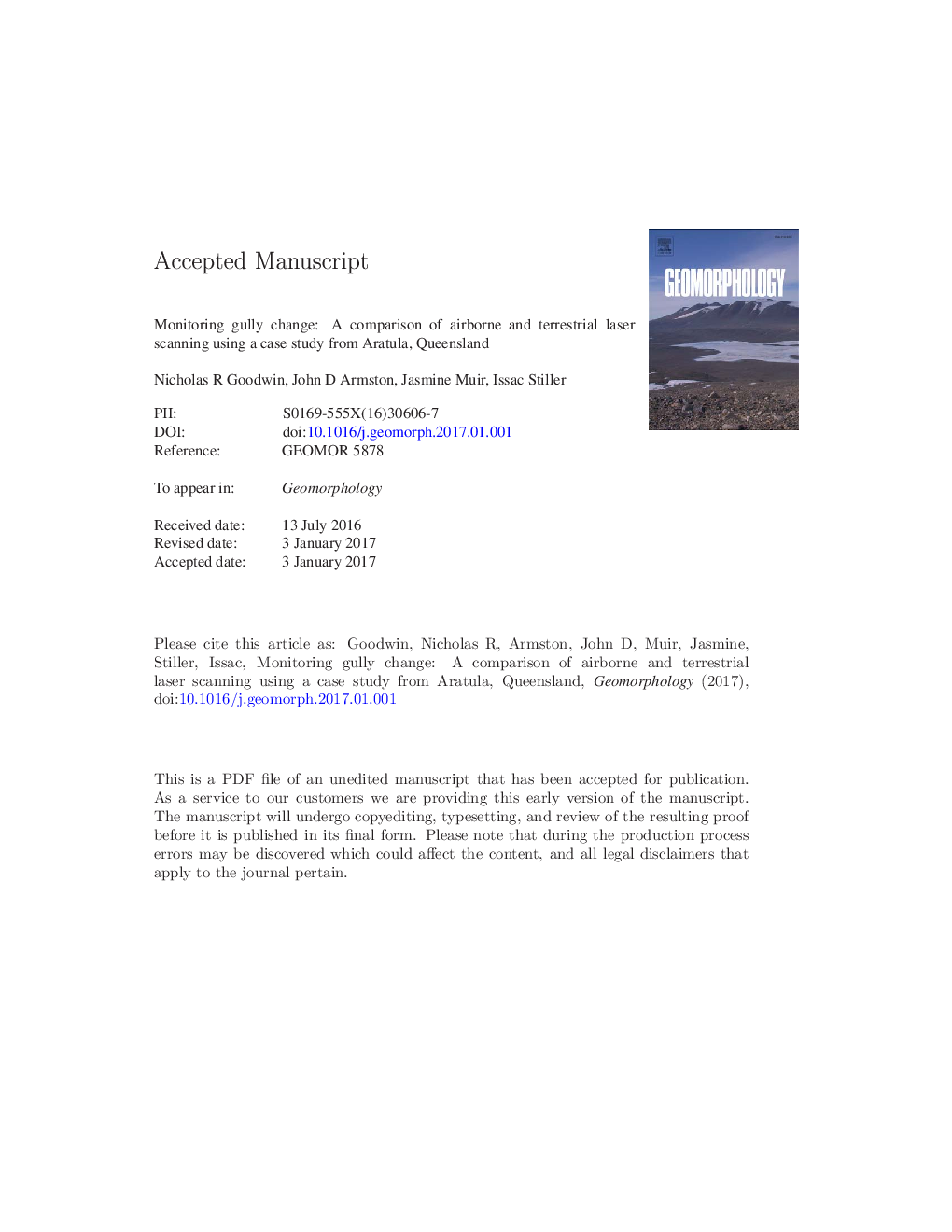| کد مقاله | کد نشریه | سال انتشار | مقاله انگلیسی | نسخه تمام متن |
|---|---|---|---|---|
| 5781127 | 1635367 | 2017 | 55 صفحه PDF | دانلود رایگان |
عنوان انگلیسی مقاله ISI
Monitoring gully change: A comparison of airborne and terrestrial laser scanning using a case study from Aratula, Queensland
ترجمه فارسی عنوان
تغییرات تغییرات جابجایی: مقایسه اسکن لیزر هوایی و زمینی با استفاده از یک مطالعه موردی از آراتولا، کوئینزلند
دانلود مقاله + سفارش ترجمه
دانلود مقاله ISI انگلیسی
رایگان برای ایرانیان
کلمات کلیدی
موضوعات مرتبط
مهندسی و علوم پایه
علوم زمین و سیارات
فرآیندهای سطح زمین
چکیده انگلیسی
Airborne laser scanning (ALS) and terrestrial laser scanning (TLS) technologies capture spatially detailed estimates of surface topography and when collected multi-temporally can be used to assess geomorphic change. The sensitivity and repeatability of ALS measurements to characterise geomorphic change in topographically complex environments such as gullies; however, remains an area lacking quantitative research. In this study, we captured coincident ALS and TLS datasets to assess their ability and synergies to detect geomorphic change for a gully located in Aratula, southeast Queensland, Australia. We initially used the higher spatial density and ranging accuracy of TLS to provide an assessment of the Digital Elevation Models (DEM) derived from ALS within a gully environment. Results indicated mean residual errors of 0.13 and 0.09 m along with standard deviation (SD) of residual errors of 0.20 and 0.16 m using pixel sizes of 0.5 and 1.0 m, respectively. The positive mean residual errors confirm that TLS data consistently detected deeper sections of the gully than ALS. We also compared the repeatability of ALS and TLS for characterising gully morphology. This indicated that the sensitivity to detect change using ALS is substantially lower than TLS, as expected, and that the ALS survey characteristics influence the ability to detect change. Notably, we found that using one ALS transect (mean density of 5 points / m2) as opposed to three transects increased the SD of residual error by approximately 30%. The supplied classification of ALS ground points was also demonstrated to misclassify gully features as non-ground, with minimum elevation filtering found to provide a more accurate DEM of the gully. The number and placement of terrestrial laser scans were also found to influence the derived DEMs. Furthermore, we applied change detection using two ALS data captures over a four year period and four TLS field surveys over an eight month period. This demonstrated that ALS can detect large scale erosional changes with head cutting of gully branches migrating approximately 10 m upslope. In comparison, TLS captured smaller scale intra-annual erosional patterns largely undetectable by the ALS dataset with a large rainfall event coinciding with the highest volumetric change (net change > 46 m3). Overall, these findings reaffirm the importance of quantifying DEM errors and demonstrate that ALS is unlikely to detect subtle geomorphic changes (< 0.45 m) potentially missing significant sediment change. TLS was able to detect more subtle intra-annual changes but was limited in its spatial coverage. This suggests TLS and ALS surveys are complementary technologies and when used together can provide a more detailed understanding of gully processes at different temporal and spatial scales, provided the inherent errors are taken into account.
ناشر
Database: Elsevier - ScienceDirect (ساینس دایرکت)
Journal: Geomorphology - Volume 282, 1 April 2017, Pages 195-208
Journal: Geomorphology - Volume 282, 1 April 2017, Pages 195-208
نویسندگان
Nicholas R Goodwin, John D Armston, Jasmine Muir, Issac Stiller,
